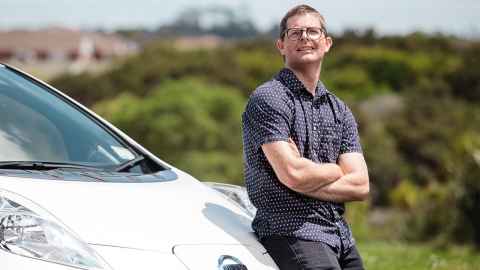Beautiful noise: Andrew Hall and the engineers pump up the volume
1 December 2021
Dr Andrew Hall says it’s good to be involved in the fast-developing technology being created for EV racing cars, alongside New Zealand's best known EV rally car driver.

Dr Andrew Hall was feeling nervous, stuck in lockdown in Auckland on Labour Weekend.
Down in Waimate, a device he worked on with engineering technologist Gian Schmid and two mechanical engineering students, Aman Sagoo and Bevan Tucker, was being taken on its first test run, attached to the EV rally car of top Kiwi rally driver Hayden Paddon. To add more pressure, the car was making its competitive debut.
For months the engineers had worked with Paddon on a device to make it sound like a “real” rally car, but like nothing heard before, as well as to improve safety for spectators.
“Motor rallies often take place in forests, and cars suddenly race out from behind trees or over blind crests,” says Andrew. “The lack of noise poses safety issues for spectators, because they don’t hear the cars coming.
“For Hayden’s EV, we modelled our sound profile on a number of engines such as the V10 F1.”
On 23 October, Andrew, a big rally fan, would have loved to be in Waimate. Instead he received a report back from the track.
“The prototype worked perfectly. It still needs improvement around its sound, but it held up well on the car.”
That was important.
“We knew it worked, but we needed to test how robust it was.”
Some EV race cars have speakers on the outside of the car, but that risks them being damaged.
“The main thing for us was to devise a mechanical system, rather than speakers which have an artificial kind of sound. We wanted to make the device lightweight with no electronic components and directly connected to the throttle response.”
Further testing will be done to ensure the device can stand up to the harsh environment of a motor rally – dust, dirt and gravel.
The EV rally cars can be faster and need to be just as exciting through noise, so that’s where we come in.
Andrew says it’s been good to be part of the fast-developing technology being created for EV racing cars. He says in motor racing forums, fans seem mixed about the idea of fully electric racing cars.
“We need to help the transition. The cars can be faster and need to be just as exciting through noise, so that’s where we come in.”
Now there’s fine tuning to do and the University of Auckland engineers hope to develop their ideas further, in conjunction with Paddon Rallysport.
“We’d like to explore other avenues … Formula E, Extreme E and even E-scooters. Hayden is pretty keen to look at patents.”
Rather than boost noise, Andrew’s usual acoustic work is to reduce it. He is in the second-year of a three-year project exploring sound insulation, focusing on intertenancy partitions, that is between apartments and flats. Being a professional jazz saxophonist, he understands situations in which better sound insulation would be a benefit.
“In New Zealand, most walls are plasterboard with wooden or steel studs. At low frequencies, such as the bass in music, they don’t block sound well due to a unique wall resonance.
“If you put more weight into the walls to counter that, it’s not ideal because, aside from the weight and added cost, it just shifts the resonance lower in frequency.”
Andrew’s group is devising bottle-like Helmholtz resonators with membranes placed into a wall system, to absorb multiple different frequencies. They are working with Winstones on the project and also looking at using the technology within double glazing in aluminium frames.
“The University is lucky to have excellent acoustic facilities in which we can do our testing – we’re one of three or four of the best in Australasia. It’s been a challenge with the lab being shut through lockdown, but hopefully things improve.”
Sounds promising.
Denise Montgomery